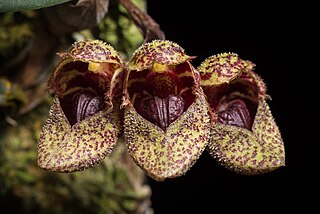
Orchids are plants that belong to the family Orchidaceae, a diverse and widespread group of flowering plants with blooms that are often colourful and fragrant. Orchids are cosmopolitan plants that are found in almost every habitat on Earth except glaciers. The world's richest diversity of orchid genera and species is found in the tropics.

Bulbophyllum is a genus of mostly epiphytic and lithophytic orchids in the family Orchidaceae. It is the largest genus in the orchid family and one of the largest genera of flowering plants with more than 2,000 species, exceeded in number only by Astragalus. These orchids are found in diverse habitats throughout most of the warmer parts of the world including Africa, southern Asia, Latin America, the West Indies, and various islands in the Indian and Pacific Oceans. Orchids in this genus have thread-like or fibrous roots that creep over the surface of trees or rocks or hang from branches. The stem is divided into a rhizome and a pseudobulb, a feature that distinguished this genus from Dendrobium. There is usually only a single leaf at the top of the pseudobulb and from one to many flowers are arranged along an unbranched flowering stem that arises from the base of the pseudobulb. Several attempts have been made to separate Bulbophyllum into smaller genera, but most have not been accepted by the World Checklist of Selected Plant Families.

Johannes Jacobus Smith was a Dutch botanist who, between years 1905 to 1924, crossed the islands of the Dutch East Indies, collecting specimens of plants and describing and cataloguing the flora of these islands. The standard botanical author abbreviation J.J.Sm. is applied to plants described by J.J. Smith.

Epidendrum denticulatum, one of the crucifix orchids, is a reed stemmed species which, at least in herbarium specimens, is frequently confused with E. secundum Jacq.

Bulbophyllum frostii, commonly known as Frost's bulbophyllum or Dutchman's shoes is a species of orchid, In the wild it grows as an epiphyte, inhabiting evergreen seasonal lowland rainforests in Vietnam and more rarely in Thailand, including the Malay peninsula. It was more recently reported growing in the Yunnan province of China during a series of botanical surveys between 2017 and 2020. This plant is usually found at elevations of around 1500m above sea level.

Bulbophyllum lobbii is a species of orchid, also known as Thailand bulbophyllum or Sumatran bulbophyllum. It was named for the plant hunter Thomas Lobb, who introduced it to England from Java in 1846.

Bulbophyllum fascinator is a species of flowering plant in the orchid family Orchidaceae, native to northeastern India, Southeast Asia, and northern Malesia. A pseudobulbous epiphyte found in lowlands, it can be confused with Bulbophyllum putidum.
Bulbophyllum abbreviatum is a species of orchid in the genus Bulbophyllum discovered in Madagascar and originally described by German botanist Rudolf Schlechter, from material collected by French botanist H. Perrier de la Bâthie in February 1912, which is now kept in the Muséum National d'Histoire Naturelle in Paris.
Bulbophyllum eublepharum is a species of orchid in the genus Bulbophyllum. Chromosome count is 2n = 38. Plants are epiphytes.

Bulbophyllum fuscopurpureum is a species of orchid in the genus Bulbophyllum.
Bulbophyllum gymnopus is a species of orchid in the genus Bulbophyllum.
Bulbophyllum keekee is a species of orchid in the genus Bulbophyllum, native to New Caledonia. It is protected in the northern province.
Bulbophyllum minax is a species of orchid in the genus Bulbophyllum found in Madagascar. It is critically endangered due to deforestation.

Bulbophyllum moniliforme is a species of orchid in the genus Bulbophyllum. It is indigenous to the Assam region in eastern India.
Bulbophyllum rhodoglossum is a species of orchid in the genus Bulbophyllum, first described by Rudolf Schlechter in 1913 in Repertorium Specierum Novarum Regni Vegetabilis. It is an epiphyte growing in Papua New Guinea on trees in mountain forests around 1000 metres in elevation. The flowers are white, and the labellum red with a yellow tip.
Bulbophyllum samoanum, also known as the Samoan bulbophyllum, is a species of orchid in the genus Bulbophyllum.

Bulbophyllum scabratum or Rough Bulb-Leaf Orchid is a species of orchid in the genus Bulbophyllum in section Eublepharon.
Bulbophyllum nocturnum is a species of epiphytic orchid that grows in New Britain. It was described in 2011, and is the first species of orchid known to consistently flower during the night, and close its flowers during the day.

Dendrobieae is a tribe in the subfamily Epidendroideae, in the family Orchidaceae. The Dendrobieae are mostly tropical, epiphytic orchids which contain pseudobulbs.
Bulbophyllum pinelianum, the rat-tail orchid, is a species of orchid in the genus Bulbophyllum. It is widespread across southern Mexico, the West Indies, Central America and northern South America. It is also reported from Florida but apparently now extinct in that state.










